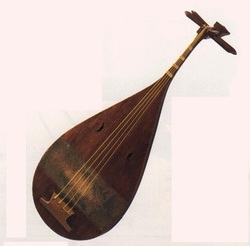

Shōko ( 鉦鼓) – small bronze gong used in gagaku struck with two horn beaters.Shime-daiko ( 締太鼓) – small drum played with sticks.Sekkin – a lithophone either bowed or struck.Sasara ( ささら) – clapper made from wooden slats connected by a rope or cord.San-no-tsuzumi ( 三の鼓) – hourglass-shaped double-headed drum struck only on one side.Rin or daikin ( 大磬) – singing bowls used by Buddhist monks in religious practice or rituals.Mokugyo ( 木魚, also called 'wooden fish') – woodblock carved in the shape of a fish, struck with a wooden stick often used in Buddhist chanting.Shakubyoshi (also called shaku) – clapper made from a pair of flat wooden sticks.Kokiriki ( 筑子、 こきりこ) – a pair of sticks which are beaten together slowly and rhythmically.Kakko ( 羯鼓) – small drum used in gagaku.Kagura suzu – hand-held bell tree with three tiers of pellet bells.Ikko – small, ornately decorated hourglass-shaped drum.Den-den daiko ( でんでん太鼓) – pellet drum, used as a children's toy.Hyoshigi ( 拍子木) – wooden or bamboo clappers.Bin-sasara ( 編木、板ささら) also spelled bin-zasara – clapper made from wooden slats connected by a rope or cord.The three strings are held on a neck, and the left hand presses the strings at points called “Kandokoro” to adjust the pitch. In addition, the thinnest string plays a high tone with the “third string”. The thickest string is called the “first string” and produces the low tone, while the middle string covers the middle tone with the “second string”. The Shamisen is described as “a string with three flavors”.Īs the name implies, three different types of strings are used separately and are of different thicknesses.

The Shamisen play it with the plectrum held in the right hand to produce a sound. It lasted until the eleventh generations, but the Shamisen, especially those made in the older generation, is called “Koomi” and is known as a masterpiece. The first generation was from Kyoto, and the second generation went to Edo. Omi Ishimura is a master Shamisen maker who has been around for generations. The left hand presses the strings on the neck and adjusts the pitch of the note. Place the body on the right knee and play it with the plectrum held in the right hand.
#JAPANESE STRINGED INSTRUMENTS SKIN#
The skin stretched on either side of the body is the skin of a cat or a dog. There are three main types of Shamisen, which are distinguished by the thickness of the neck: the Futozao, the Chuzao and the Hosozao. The Shamisen is a stringed instrument consisting of a neck (棹), body (胴) and strings (弦). The Tsugaru Shamisen, which originated in Aomori, is popular today for its gorgeous sound and performance. The Shamisen is used not only as an accompaniment to Kabuki and Bunraku, but also for Nagauta, Koto and folk music, making it an indispensable instrument in Japanese music.

So the Shamisen was used by the common people of Edo. In the Edo period, restrictions on the use of musical instruments were in place: Gagaku was restricted to nobles, Noh to samurai families, Koto music to the blind, and Shakuhachi to Komuso, monks. The Shamisen was introduced to Japan around 1560 from China, where the Shamisen originated as a sangen, musical instrument, through the Ryukyu (present-day Okinawa).ĭue to its operability and wide range of applications, the Shamisen became widely popular in the Edo period and is now widely recognized as one of Japan’s traditional musical instruments. It was widely popular as a practice for the common people in old days. Hogaku (Japanese traditional music) refers to the ancient Japanese music that developed in the early modern era, such as the Shamisen, Koto and Shakuhachi. About Hogaku (邦楽-Japanese traditional music)


 0 kommentar(er)
0 kommentar(er)
